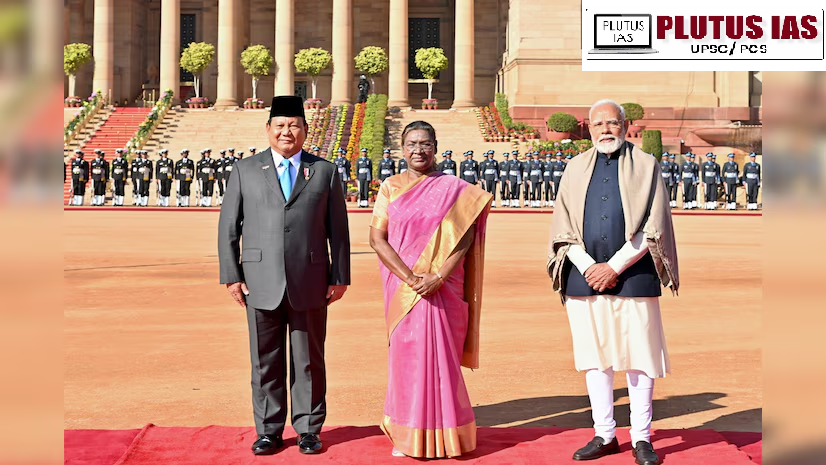27 Jan Bridging Nations: The Growing Partnership Between India and Indonesia
SYLLABUS MAPPING:
GS-2-International Relations-Bridging Nations: The Growing Partnership Between India and Indonesia
FOR PRELIMS:
Geographical features of Indonesia, key Agreements between India and Indonesia key facts about Harimau Shakti.
FOR MAINS
Why in the news?
Indonesian President Prabowo Subianto’s visit to India is set to deepen the strategic partnership between the two countries, reflecting Indonesia’s ambition to play a larger role globally. Despite occasional differences in global outlook, the growing collaboration between India and Indonesia, bolstered by successful foreign ministerial relations and shared G20 presidencies, points to a more coherent partnership. A key challenge lies in how India’s Foreign Minister, S. Jaishankar, connects with Indonesia’s new foreign minister, Sugiono, to strengthen this high-profile relationship further.

Evolution of India – Indonesia Bilateral Relations:
| Phase | Timeline | Key Events and Developments |
|---|---|---|
| Phase 1: Foundation and Early Engagement | 1950 – 1970 | Formal diplomatic relations were established in 1950. Bandung Conference in 1955, both co-founders of the Non-Aligned Movement (NAM). Cooperation on anti-colonial struggles and sovereignty. |
| Phase 2: Expanding Ties and Strategic Cooperation | 1970 – 2000 | Increased focus on regional cooperation and multilateral diplomacy. The signing of MoUs on defence, trade, and other sectors. 1992: Start of India’s “Look East Policy”. 1998: Greater defence and economic collaboration. |
| Phase 3: Comprehensive Partnership and Strategic Engagement | 2000 – 2014 | 2001 MoU, formalizing bilateral cooperation. 2005: Upgrade to Strategic Partnership. Growth in trade, defence, and cultural exchange. Enhanced collaboration in regional security and defence. |
| Phase 4: Enhanced Strategic Partnership and Global Cooperation | 2014 – Present | “Act East” policy boosts cooperation in defence, trade, and regional security. 2017: Bilateral trade surpasses $20 billion. 2018: Modi’s visit solidifies Comprehensive Economic Partnership. Focus on maritime security, climate change, and sustainable development. |
Areas of Cooperation:
1. Maritime Security: Joint naval exercises (e.g., Samudra Shakti, IND-INDO CORPAT) to enhance interoperability and address piracy, terrorism, and other maritime threats.
2. Defense & Security:
Strategic Partnership: Joint military training, technology sharing, and defence exports (e.g., BrahMos, Light Combat Aircraft).
Military Engagements: Increased naval operations like INS Sindhukesari’s operational turnarounds.
3. Trade & Economic Cooperation: Bilateral trade reached USD 38.85 billion in 2022-23, with strong ties in energy (coal, palm oil) and infrastructure, including Sabang Port development.
4. Cultural & People-to-People Ties: Shared cultural history through the Ramayana and Mahabharata; cultural exchanges via the Swami Vivekananda Cultural Centre.
5. Education & Capacity-Building: Capacity-building programs like ITEC and scholarships for Indonesian students in India. Humanitarian support, such as Operation Samudra Maitri post-2018 earthquake and tsunami.
6. Regional & Multilateral Cooperation: Active participation in forums like ASEAN, IORA, G20, and East Asia Summit, focusing on maritime security, trade, and climate change.
7. Science & Technology: Collaboration in space, IT, and green tech; alignment on climate action and the International Solar Alliance.
8. Climate Change & Sustainability: Joint initiatives on renewable energy, climate resilience, and disaster management.
Significance of Indonesia for india:
1. Strategic Partner: Key to India’s Indo-Pacific vision, supporting free, open, and inclusive maritime security, especially through multilateral forums (EAS, IORA).
2. Maritime Security & Connectivity: Critical for securing shipping lanes, with initiatives like Sabang Port improving access to the Malacca Strait.
3. Economic Cooperation: Major trade partner, with USD 38.85 billion in trade; significant supplier of coal and palm oil.
4. Defense Ties: Joint naval exercises and defence exports, including BrahMos missiles.
5. Cultural Ties: Shared history, especially through Ramayana and Mahabharata; cultural centres foster bilateral exchanges.
6. Counterbalance to China: Helps India mitigate China’s growing influence in the region.
Raising concern in India -Indonesia Relations:
1. Trade Imbalance: India’s trade deficit with Indonesia was USD 21 billion in 2022-23, with imports (mainly coal and palm oil) outpacing exports.
2. Regulatory Hurdles: Different defence acquisition processes hinder joint ventures and defence cooperation.
3. China’s Influence: Indonesia’s involvement in China’s Belt and Road Initiative (e.g., high-speed rail projects) raises concerns for India.
4. Connectivity Issues: Limited air connectivity (20 flights/week) and visa challenges restrict business and tourism exchanges.
5. Political Focus: Indonesia’s ASEAN-centric approach sometimes diverts attention from deeper bilateral engagement with India.
6. Economic Underutilization: Bilateral trade potential is USD 61 billion, but current trade is underperforming at USD 38.85 billion.
7. Defense Delays: Joint defence projects, like BrahMos missiles, face slow progress due to differing procurement systems.
8. Environmental Concerns: Palm oil imports from Indonesia face criticism over deforestation, impacting the trade relationship.
Way to strengthen bilateral ties:
1. Boost Trade & Investment: Fast-track CEPA and explore new sectors like IT, renewable energy, and manufacturing.
2. Defense Cooperation: Expand joint military exercises, technology transfer, and maritime security initiatives.
3. Improve Connectivity: Enhance direct flights, ease visa processes, and develop port infrastructure like Sabang.
4. Cultural Exchanges: Promote shared cultural heritage, yoga, and religious exchanges, fostering people-to-people links.
5. Tech & Research Collaboration: Partner on R&D and technology projects in areas like renewable energy and healthcare.
6. Maritime Security: Expand initiatives like IND-INDO CORPAT and Samudra Shakti to strengthen regional security.
7. Multilateral Engagement: Collaborate more within ASEAN, IORA, and the East Asia Summit on security and growth.
8. Sustainable Development: Work on climate change, disaster resilience, and joint projects under the International Solar Alliance.
Download Plutus IAS Current Affairs (Eng) 27th Jan 2025
Conclusion
India-Indonesia relations have grown strong, focusing on defence, trade, maritime security, and cultural exchange. Despite challenges like trade imbalances, regulatory issues, and Indonesia’s ties with China, both countries have maintained close cooperation on regional platforms like ASEAN and G20. To strengthen ties, efforts should focus on fast-tracking the CEPA, expanding defence and trade collaboration, improving connectivity, and enhancing cultural ties. Increased cooperation in renewable energy and technology will unlock further potential, solidifying their role as key Indo-Pacific partners.
Prelims Question:
B. India-Indonesia Strategic Partnership, 2005
C. Formal diplomatic relations, 1950
D. India-Indonesia Comprehensive Economic Partnership, 2018
Mains Question:
(250 words, 15 marks)




No Comments